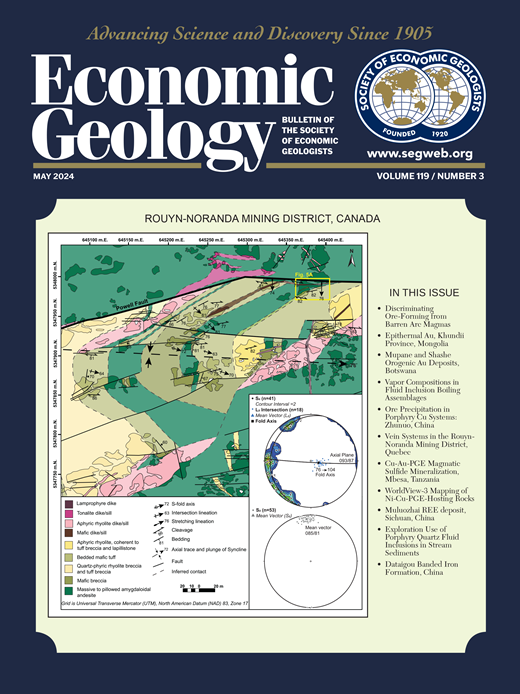Stream Sediment Indicator Mineral Signatures of the Casino Porphyry Cu-Au-Mo Deposit, Yukon, Canada
IF 4.9
1区 地球科学
Q1 GEOCHEMISTRY & GEOPHYSICS
引用次数: 1
Abstract
Case studies around porphyry Cu deposits in the glaciated regions of the Canadian Cordillera have identified the indicator mineral signatures of these deposits in till samples and demonstrated that these are useful methods for porphyry Cu exploration. This study applies the same indicator methods to stream sediment samples around the Casino calc-alkaline porphyry Cu-Au-Mo deposit in the unglaciated terrain of west-central Yukon, Canada. It is one of the largest porphyry Cu-Au-Mo deposits in Canada and is hosted in Late Cretaceous quartz monzonite and associated breccias. Bulk (8–16 kg) coarse-grained stream sediment samples were collected in creeks around the deposit, nearby porphyry Cu occurrences and background areas. The Casino deposit has an obvious indicator mineral signature in the <2-mm heavy (>3.2-specific gravity [SG]) and mid-density (2.8- to 3.2-SG) fractions of stream sediments that is detectable at least 18 km downstream and includes gold, chalcopyrite, tourmaline, molybdenite, sphalerite, jarosite, goethite, and pyrite. In contrast, not all of these mineralogically anomalous samples have corresponding anomalous geochemical signatures in the fine fraction. The porphyry indicator minerals identified in this study are similar to those reported for glaciated terrain with the addition of molybdenite and secondary minerals. Indicator mineral methods provide physical evidence of nearby mineralization and can be chemically analyzed to provide insights about the nature of the mineralizing system. Government and exploration surveys could benefit from the addition of indicator mineral methods to routine stream sediment sampling protocols in unglaciated regions of the Yukon and elsewhere globally where porphyry Cu exploration is conducted.加拿大育空卡西诺斑岩铜-金-钼矿床水系沉积物指示矿物特征
围绕加拿大科迪勒拉冰川地区斑岩铜矿的案例研究已经确定了这些矿床的指示矿物特征,并证明这些是斑岩铜矿勘探的有用方法。本研究将相同的指示方法应用于加拿大育空中西部无冰川地形的Casino钙碱性斑岩Cu-Au-Mo矿床周围的河流沉积物样本。它是加拿大最大的斑岩型铜、金、钼矿床之一,赋存于晚白垩世石英二长岩及其伴生角砾岩中。大块(8-16公斤)粗粒度水系沉积物样本采集于矿床周围的小溪、斑岩型铜矿点附近和背景区。卡西诺矿床具有明显的指示矿物特征,在下游至少18公里处可探测到的溪流沉积物的3.2比重(SG)和中密度(2.8- 3.2 SG)部分,包括金、黄铜矿、电气石、辉钼矿、闪锌矿、黄钾铁矾、针铁矿和黄铁矿。相反,并非所有这些矿物学异常样品在细粒中都具有相应的异常地球化学特征。本研究鉴定的斑岩指示矿物与已报道的冰川地形相似,并添加了辉钼矿和次生矿物。指示矿物方法提供了附近矿化的物理证据,并且可以通过化学分析来了解矿化系统的性质。政府和勘探调查可以从在育空地区和全球其他地方进行斑岩铜勘探的无冰川地区的常规河流沉积物采样协议中添加指示矿物方法中受益。
本文章由计算机程序翻译,如有差异,请以英文原文为准。
求助全文
约1分钟内获得全文
求助全文
来源期刊

Economic Geology
地学-地球化学与地球物理
CiteScore
10.00
自引率
6.90%
发文量
120
审稿时长
6 months
期刊介绍:
The journal, now published semi-quarterly, was first published in 1905 by the Economic Geology Publishing Company (PUBCO), a not-for-profit company established for the purpose of publishing a periodical devoted to economic geology. On the founding of SEG in 1920, a cooperative arrangement between PUBCO and SEG made the journal the official organ of the Society, and PUBCO agreed to carry the Society''s name on the front cover under the heading "Bulletin of the Society of Economic Geologists". PUBCO and SEG continued to operate as cooperating but separate entities until 2001, when the Board of Directors of PUBCO and the Council of SEG, by unanimous consent, approved a formal agreement of merger. The former activities of the PUBCO Board of Directors are now carried out by a Publications Board, a new self-governing unit within SEG.
 求助内容:
求助内容: 应助结果提醒方式:
应助结果提醒方式:


